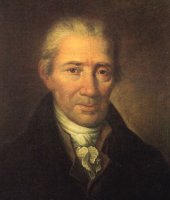1736. 2. 3 빈 근처 클로스터노이부르크~ 1809. 3. 7 빈.
오스트리아의 작곡가, 오르간 연주자, 음악이론가.
대위법에 관한 한 그 시대의 가장 박식하고 숙련된 작곡가의 한 사람이었다. 그의 명성 때문에 베토벤을 포함한 많은 제자들이 그에게로 몰려들었다.
레오폴트 피트너에게 오르간과 계속저음을 배웠으며 1755~66년 오르간 연주자로 여러 직책을 거쳤다. 1772년 빈에서 보조 궁정 오르간 연주자가 되었으며 1792년부터는 장크트 스테파누스 대성당의 음악감독으로 일했다.
250여 곡 되는 대부분의 작품들은 원본이 남아 있다. 작품으로는 26곡의 미사곡, 12곡의 현악 4중주, 하프 협주곡과 다수의 종교음악, 실내음악이 있으며 이론서로는 〈작곡의 기초 Gründliche Anweisung zur Composition〉(1790)가 있다. 그의 이론적 저술들은 제자인 이그나츠 리터 쿠사버 폰 자이프리트에 의해 1826년 3권의 책으로 출판되었다.
그의 작품들에서 선정한 발췌곡들은 〈오스트리아 음악 예술의 기념작들 Denkmäler der Tonkunst in Österreich〉(16권 2호, 1909)에 실려 있다.
Biography
Albrechtsberger was born at Klosterneuburg, near Vienna. He originally studied music at Melk Abbey and philosophy at a Benedictine seminary in Vienna and became one of the most learned and skillful contrapuntists of his age. Albrechtsberger's earliest classmates included Michael Haydn and Franz Joseph Aumann.[2] After being employed as organist at Raab in 1755 and Maria Taferl in 1757, he was appointed Thurnermeister back at Melk Abbey. In 1772 he was appointed organist to the court of Vienna, and in 1792 Kapellmeister of St. Stephen's Cathedral.
His fame as a theorist attracted to him in the Austrian capital a large number of pupils, some of whom afterwards became eminent musicians. Among these were Johann Nepomuk Hummel, Ignaz Moscheles, Josef Weigl (1766–1846), Ludwig-Wilhelm Tepper de Ferguson (1768 – after 1824), Antonio Casimir Cartellieri, Ludwig van Beethoven, Anton Reicha and Franz Xaver Wolfgang Mozart. See: List of music students by teacher: A to C#Johann Georg Albrechtsberger. Beethoven had arrived in Vienna in 1792 to study with Joseph Haydn but quickly became infuriated when his work was not being given attention or corrected.
Haydn recommended his friend Albrechtsberger, with whom Beethoven then studied harmony and
counterpoint.[3] on completion of his studies, the young student noted, "Patience, diligence, persistence, and sincerity will lead to success," which reflects upon Albrechtsberger's own compositional philosophies.
When Beethoven was finished studying with Albrechtsberger he decided to get a few more tips and pointers, so to speak, from Haydn. From there Beethoven possibly studied with Salieri, but this is unknown as a fact. It is also quite possible that Beethoven went off on his own to make a living, and only then returned after he had a stable career.
Albrechtsberger died in Vienna; his grave is in St. Marx cemetery.
Compositions
======================================================
His published compositions consist of preludes, fugues and sonatas for the piano and organ, string quartets, etc.; but the greater proportion of his works, vocal and instrumental, exists only in manuscript. They are in the library of the Vienna Gesellschaft der Musikfreunde. Around 1765, he wrote at least seven concerti for jaw harp and strings (three survive in the Hungarian National Library in Budapest). They are pleasant, well written works in the galant style. one of his most notable works is his concerto for Alto Trombone and Orchestra in B♭ Major. As the trombone has few works dating back to the classical period, his concerto is often highlighted by the trombone community. He also wrote a Concerto for the Mandola, Op. 27, written positively about in the 1914 book The Guitar and Mandolin.
=============================================
========================================================
Probably the most valuable service he rendered to music was in his theoretical works. In 1790 he
published at Leipzig a treatise on composition, of which a third edition appeared in 1821. A collection of his writings on harmony, in three volumes, was published under the care of his pupil Ignaz von Seyfried (1776–1841) in 1826. An English version of this was published by Novello in 1855. His compositional style derives from Johann Joseph Fux's counterpoint, who was Kapellmeister at St Stephen's Cathedral 1713-1741, a position that Albrechtsberger would hold 52 years later
A continuous thread can be traced from his teaching through that of his pupil Reicha, who went on to become the first Professor of Counterpoint and Fugue at the Paris Conservatoire from 1818 to his death in 1836, and who in turn reached a wide audience through both his own teaching and his theoretical writings, which were standard reference at the Conservatoire for most of the 19th century and translated into German by Czerny.
'♣ 음악 감상실 ♣ > * 음악가 별' 카테고리의 다른 글
| [이탈리아]Giovanni Battista Viotti (0) | 2015.07.14 |
|---|---|
| [폴란드계 오스트리아]Antonio Casimir Cartellieri (0) | 2015.07.13 |
| Gaetano Pugnani (0) | 2015.07.09 |
| [프랑스]François Devienne (0) | 2015.07.07 |
| (A close friend of Haydn, Mozart, and Beethoven) Antonín Kraft (0) | 2015.07.06 |
